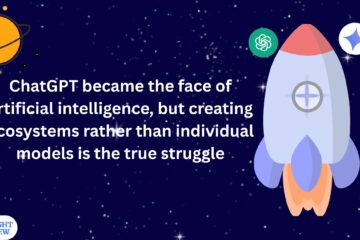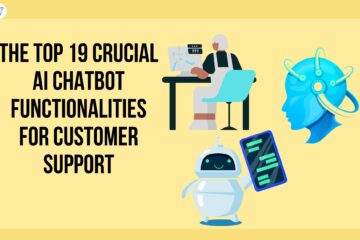The future of chatbots is poised to achieve what they’ve always promised. Here’s how your business can harness its potential.
Conventional conversationalist chatbots were generally uninteresting. Early iterations relied on strict, rule-based scripts, which made interactions frustrating and robotic. However, chatbots have the potential to develop into dynamic, context-aware assistants because of advances in artificial intelligence, especially conversational and agentic AI.
These days, companies are embracing chatbots. The chatbot market is expected to reach $7B USD this year, and grow to nearly $21B by 2029. Applications like WhatsApp, WeChat, and Facebook Messenger are driving chatbot adoption, enabling businesses to deliver more responsive, data-driven customer interactions.
However, despite these developments, the majority of chatbots continue to be reactive; they rarely take action beyond responding to queries. The next development in chatbot intelligence is agentic AI. Agentic AI can make decisions, automate multi-step tasks, and proactively help customers, which makes digital interactions more intuitive and seamless than traditional AI chatbots that depend on preset workflows.
This change is a watershed. Chatbots are evolving into self-governing digital agents that can have a significant impact on business, going beyond simply responding to enquiries. However, companies must reconsider their chatbot strategy to realise this potential fully.
Chatbots of the Future: Conversational and Agentic AI
Chatbots were once simple, rules-based programs, but conversational AI has made them intelligent, human-like assistants. These artificial intelligence (AI)-driven systems interpret queries and produce more pertinent, contextual responses by utilising machine learning, natural language processing (NLP), and natural language understanding (NLU). Although this has been a significant advancement, many chatbots still have trouble making decisions, remembering context, and solving complicated problems.
Agentic AI is useful in this situation. Agentic AI is capable of making decisions, taking initiative, and carrying out multi-step tasks without continual human guidance, in contrast to traditional conversational AI, which mostly responds to user inputs. Consider it the distinction between a chatbot that merely responds to enquiries and one that proactively resolves problems, like resolving account issues.
However, many organisations still struggle with deploying AI-powered chatbots that are dependable, safe, and effective. Chatbots frequently fall short of their full potential due to data fragmentation, a lack of contextual awareness, and reliance on antiquated rules-based systems.
Professor Mollick Ethan of the University of Pennsylvania’s Wharton School thinks these obstacles will eventually be lifted. He Writes:
“Many things that once seemed exclusively human will be able to be done by AI. By embracing this principle, businesses can view AI’s limitations as transient, ensuring they stay competitive in a fast-paced digital world.”
Together, conversational and agentic AI are enabling chatbots to do more than just exchange messages. They are developing into self-governing digital agents that can provide customers with more intelligent, proactive, and seamless experiences. However, since even the most sophisticated AI is only as good as the data it has access to, the secret to success is how well businesses incorporate high-quality, unified data into their chatbot systems.
The Problems With Today’s Chatbot Technology
The reality of what an AI chatbot can actually deliver differs greatly from what marketers and organisations are promising.
It’s critical to remember the following as AI-powered chatbots and chatbot dialogues become more prevalent in business interactions and proactive customer support:
There are currently no emotionally intelligent chatbots.
Because chatbot technology is so concrete, it is a part of the larger AI narrative. When a user asks a question to a chatbot such as ChatGPT or Google Assistant, the bot cheerfully replies, “Sure! I am able to assist with that. However, what about an emotionally intelligent chatbot that can recognise the subtleties of human emotion, decipher emotional cues, and then produce the appropriate kind of sympathetic AI response?
Well, we haven’t arrived yet.
Indeed, chatbots can comprehend and interpret human language with the aid of machine learning and natural language processing. This is what enables them to surpass the “user says x, chatbot responds y” functionality and better replicate actual human interaction. However, even though AI-powered chatbots can react to consumer enquiries with what appears to be genuine human emotion, they are still falling short of our expectations in terms of human conversation. Empathy and emotional reactions are still difficult for an AI bot to master.
With the help of technologies like sentiment analysis, facial recognition (to better understand facial expressions), emotional tone recognition, and empathic voice interface (EVI), companies like Hume AI are attempting to develop emotional intelligence. The goal of all of this is to enhance chatbot response and enable more suitable emotional AI.
Contextual awareness is still lacking in many bots.
Consumers expect your chatbot or AI assistant to be as knowledgeable as Google, but this is only possible if chatbot solutions have access to all of your data repositories so they can respond to their enquiries or connect users to the appropriate information.
In order for a chatbot to fully comprehend user context and address customer issues, enterprise data must be seamlessly integrated. Without this, chatbots can’t fully respond to enquiries or offer the same degree of customer service as a human agent.
Additionally, complex connections and data governance present challenges, even though certain chatbots can connect to multiple data silos.
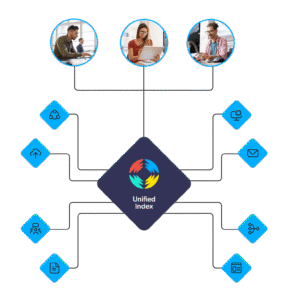
They don’t operate alone.
Your AI agent cannot access your data if it is not available, such as when it is offline or stored in a system that is not part of your primary data ecosystem. This is closely related to the contextual knowledge point. Due to their restricted access to data, AI bots frequently suffer from “death by data silo.”
When a chatbot is “chatting with” a customer, it must have access to all of the customer’s contextual information, as well as any location where the customer’s question might be found.
That answer may be found on various websites, customer communities, and product documentation sites. Access to this necessary information is essential for both customer success and exceptional customer service.
When it comes to user experience, they fall short.
In summary, if you consider chatbots to be a substitute for your customer service representatives, your customers will become irritated. Be open and honest about using AI. Set up your bot to understand its limitations and seamlessly transition to a human agent when necessary.
Any of the aforementioned problems with your chatbot are likely to result in a bad overall customer experience and an irate phone call to a poor, unwary call centre representative.
The potential of AI chatbots to enhance customer service and offer distinctive responses to consumer enquiries outside the constraints of rules-based workflows is where their true value lies. Conversational AI, agentic AI, and generative answering are all merging with unified search, another crucial component.
Where Most Companies Error When Using Chatbots
When many businesses look back on their chatbot project in a year, what will they regret? All of these suggestions, for the most part, boil down to not establishing precise objectives and expectations when talking with your team about developing an AI chatbot.
Chatbots are not a magic bullet and won’t solve every problem your customers have. Examine each customer interaction and completely restructure your customer journey if that’s what you’re after. Although a chatbot is just one component of that customer journey, it can be an essential touchpoint to raise customer satisfaction levels and brand loyalty.
Just be careful not to make these errors:
#1 No clear personality or goal for the chatbot
It’s better to have no chatbot than one that doesn’t work well. Less than 10% of consumers reported using a chatbot for their most recent customer service interaction in a Gartner survey. Regardless of the tool—voice bot, voice assistant, or generative AI chatbot—if you don’t have a clear goal in mind, your chatbot could end up hurting rather than helping your customers.
Additionally, chatbots can be very beneficial if your clients have reasonable expectations about their capabilities, understand their limitations, and know when they will be appropriately transferred to a live agent.

Customers still want a human-like experience even if they are aware that they are interacting with a chatbot. Examine your most recent customer service encounter to determine the branching, conversation flows, etc. Treating the project as a technical one instead of one that is customer-centric and aimed at satisfying customer needs would be the biggest error.
#2 Excessive expectations
Chatbots of the future might be able to handle all of your customers’ needs, including taking orders, scheduling deliveries, and solving complicated problems. However, current AI technology is still in its infancy.
Limit your expectations for your first chatbot to knowledge-based conversational questions for the time being. For instance, shopping assistants can serve as virtual sales representatives and offer necessary information regarding particular products and company policies
Rufus, Amazon’s generative AI-powered shopping assistant, which debuted in 2024, is a prime illustration of how chatbots in retail are developing. Rufus, accessible to American consumers via the Amazon app, responds to enquiries while they shop.
#3 Considering chatbots as distinct consumer interactions
Customers have a consistent experience with your brand through their interactions with your chatbot, website, call centre, mobile app, and more.
You’re losing the contextual awareness that each of these channels requires to offer a more individualised experience if you continue to see each of these interactions as distinct and don’t share the information and insights acquired across these channels.
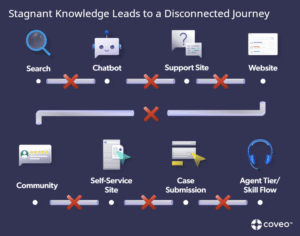
Your customer just bought a product, is looking through several pages to try to fix a problem with it, and then starts a chat. Your chatbot is adding friction to your customer experience and frustrating your customer if it doesn’t recognise right away that they are probably resolving issues related to that purchase and tailor the results to their questions based on their online behaviour.
#4 No roadmap for enterprise chatbots
How do you envision your chatbot developing in the future? How will your customer experience evolve? Don’t waste your money if this is a one-time project to address an urgent problem. You’re discussing a significant financial commitment, and that commitment must be in line with your strategic priorities and objectives.
Make sure your customer experience strategy has a roadmap with small, quantifiable milestones that lead to immediate wins. Have a realistic outlook on how technology will develop and where you want it to take your business.
#5 Not putting your chatbot’s insights to use
This is the most frequent problem we observe with investments in chatbots driven by AI. Where else are your customers asking for what they need and expressing their concerns directly? This technology is a treasure trove of customer questions, information, and insights. You should reconsider why you are developing a chatbot in the first place if you do not have a strategy in place to use each and every insight to improve your experiences and products.
You can use the information to develop a content strategy to fill in the “content gaps” on your website and make the user experience more seamless as you begin to identify the questions that your chatbot is unable to answer or that cause the customer to ask more questions.
Chatbot Technology’s Future
Whether your business uses voice bots, virtual assistants, or conversational AI chatbots, the technology is ready to integrate with anything, including websites, CRMs, Slack channels, and your company’s intranet. Instead of navigating multiple websites and interacting with multiple chatbots, the virtual assistant will serve as the platform for locating the answers you require.
According to 70% of the 4,000 consumers polled for our 2024 Commerce Industry Report, generative AI will improve their shopping experience. All signs point to a future of “conversational commerce,” in which customers converse with agents driven by artificial intelligence while they shop online.
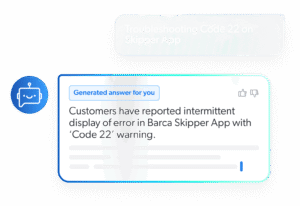
However, there are still some obstacles to overcome as technology develops and businesses like Walmart, Amazon, eBay, and Ikea push the boundaries of AI-powered assistants and bots. Customers are still leery of these tools and would rather communicate with human agents than robotic assistants, especially when addressing complicated problems or enquiries. If the chatbot gives inaccurate or flawed information, businesses risk legal repercussions or reputational damage.
